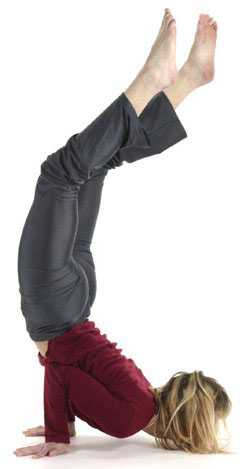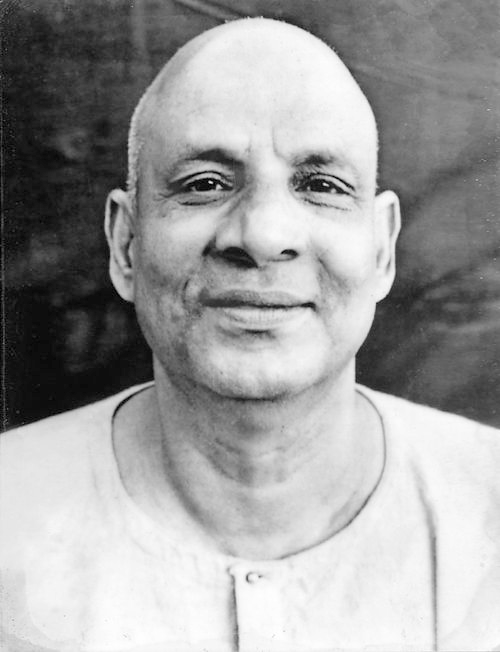

Mayurasana
«Mayurasana», the «Peacock Position», is an exercise(Asana) in Hatha Yoga for the health of the digestive organs and mental alertness. «Mayurasana» is the 10th Asana within the 12 Basic Postures of the Yoga Vidya series, although it is usually replaced by «Kakasana», the «Crow».
Table of Contents
1 Sukadev on Mayurasana
2 Execution of Mayurasana
2.1 Effects of Mayurasana
2.2 Possible aids for Mayurasana
3 Swami Sivananda on Mayurasana
3.1 Method
3.2 Benefits
3.3 Variations
3.4 Narayani shows Hamsasana and Mayuri (English)
Sukadev on Mayurasana
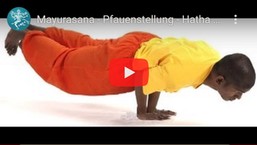
 |
 |
Execution of Mayurasana
In the following video Sukadev explains the execution of «Mayurasana». Below, Swami Sivananda describes in words the approach and the effects from his point of view.
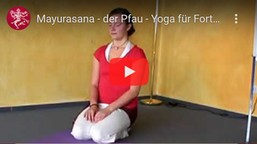
 |
 |
Effects of Mayurasana
Keeping balance in «Mayurasana» — the «Peacock» — requires all the strength and concentration. When the Asana is performed correctly, the head, body and legs are in a straight line parallel to the ground. The posture aids the digestion — even if you can't balance on your hands, because your body weight pushes your elbows into your lower abdomen, massaging the spleen and pancreas. Once you've mastered this Asana, try a more advanced hand position: either support you on your fists or let your fingertips point toward your head instead backwards.
- Physical: «Mayurasana» is considered the most effective exercise for the digestive organs. The main artery in the abdomen is compressed by the pressure of the elbows. The subsequent increased blood supply helps the digestive organs, strengthening the liver as well as the stomach and pancreas. «Mayurasana» helps to regenerate the whole nervous system. «Mayurasana» strengthens the arm muscles and increases lung capacity.
- Stretched muscles: shoulder muscles
- Strengthened muscles: Pectoralis (chest muscles), latissimus (broad back muscles), forearm muscles, triceps (arm extensors), longissimus (long back muscles), gluteus (gluteal muscles).
- Energetic: «Mayurasana» has a strong activating and awakening effect. «Mayurasana» is highly recommended in the morning and whenever energy needs to be activated quickly and effectively.
- Chakras involved: Manipura, Ajna
- Mental: «Mayurasana» develops self-confidence, courage, concentration, willpower and balance.
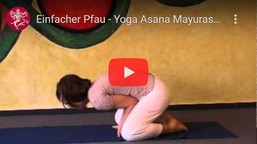
 |
 |
Possible aids for Mayurasana
If, despite a lot of effort, you do not want to succeed, two aids, namely a belt or a cushion (yoga mat) could be helpful.
- Pillow: Sometimes the proportions are a bit unevenly distributed, so that with shorter arms in relation to the upper body, it is already difficult to bring the legs up. For this, take your meditation pillow and give it between your upper arms and your torso. This creates greater leverage and thus the «Peacock» is suddenly for many peoples easier to do. Keep practicing in this way. After a while, however, you should try again to manage without the pillow. Instead of a pillow, you can also roll up your yoga mat and use it in the same way as the pillow.
- Belt: For some students, the proportions are such that when they try to get into the «Peacock», their elbows always slip outward. If this is still due to clothing, is the use of a belt recommended here. Make a loop and pass both arms through it and the belt is approximately at the level above the elbow joints. When you now go into the «Peacock», the elbows cannot slip apart because of the fixation.
Swami Sivananda on Mayurasana
«Mayur» means «Peacock» in Sanskrit. When this Asana is performed, it resembles a «Peacock» with the peacock's wheel (the feathers on its tail) stretched wide open. This Asana is a little more difficult than «Sarvangasana» and «Matsyasana». It assumes a good physical condition, gymnasts can take in this posture very easily. This is more or less the same as the pure exercise on the bars.
Method
Kneel on the ground. Sit on your toes. Lift the heels. Bring the forearms together. Place both palms on the ground. The little fingers should be placed close together or close to each other. The thumbs should be touching the ground. They should point in the direction of the feet. Now you have stable and firm forearms to support the whole body when you will lift the legs and torso in the following. Now slowly bring the lower abdomen down against the elbows which lying next to each other. Support the body by pressing your elbows into your belly button now. This is the first stage.
Novices usually find it difficult to maintain balance once they lift their legs off the ground. Place a pillow in front of you. Occasionally you will fall forward and possibly slightly injure your nose. Try sliding onto your side when you can't keep your balance. If you find it difficult to extend both legs backward at once, then extend one at a time. If you take the version where you lean the body forward and return the head, the legs will automatically lift off the ground and you can extend them with relative ease. When the Asana is fully stood, the head, torso, ischial tuberosities, thighs, legs and feet will be in a straight line. This posture is very beautiful to look at.
Beginners can practice this Asana by holding onto the sides of a bed. They will find practicing easy this way. If you use your common sense, you will be able to balance without too much difficulty. Thicker exercisers should be careful to avoid falling or sliding. Do not be jerky in the process of foot straightening. Practice this Asana for 5- 20 seconds. Those who are in good physical condition can practice for 2- 3 minutes. Hold your breath as you raise your body. When you come out of the Asana, exhale slowly.
Benefits
«Mayurasana» has its own inherent charm. The Asana will quickly focus your strength. Within a few seconds you will have a complete training. The Asana is similar to a subcutaneous injection of adrenaline or digitoxin.
It is a wonderful Asana to improve digestion. It destroys the effects of unhealthy eating. It improves the digestive power. Through it, even the digestion of the terrible Halahala toxin becomes possible and the effects are reduced. The practice cures indigestion, and diseases of the gastrointestinal tract, such as chronic gastritis, and reduces an enlargement of the liver and spleen by improving the pressure in the abdomen. The lungs and all internal abdominal organs are appropriately stimulated and stimulated by improved abdominal pressure. Sluggish liver function or paralysis due to hepatitis disappears. The Asana stimulates the intestinal function, eliminates constipation (conventional, chronic and habitual) and awakens the «Kundalini». It wonderfully stimulates the appetite, eliminates all diseases due to excessive wind, anger or laziness, cures diabetes, hemorrhoids and strengthens the arm muscles. This Asana can give you maximum physical exercise in a very short time.
Variations
I. Lolasana: Build up «Padmasana», the «Lotus Seat». Sit in the first phase of «Mayurasana». Your body weight will be on your knees and hands. Then slowly raise your lower body which sit in «Padmasana». Performed with «Padamasna» this is a kind of swinging posture. It is called «Lolasana». You will also experience the benefits of «Mayurasana» in this Asana.
II. Hamsasana: a kind of goose. The Asana is relatively easy to take. This temporarily execution of «Mayurasana» is known as «Hamsasana». Here, the toes are left on the ground before the legs are raised for «Mayurasana».
Narayani shows Hamsasana and Mayuri (English)
«Hamsasana» is a good preparation for the full «Peacock». The following «Mayuri» is something like the «Little Peacock». Finally Narayani shows «Pincham Mayurasana», this symbolizes the tail feather of a peacock.
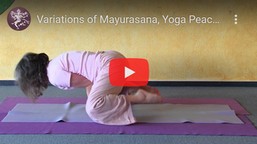
 |
 |
It is often asked by students how best to prepare to learn «Peacock». In fact, it helps best to practice «Mayurasana» over and over again. Gladly also about the intermediate steps of «Hamsasana».

